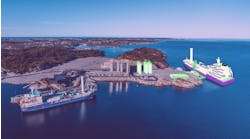OGA sees opportunities ahead for UK North Sea projects
Offshore staff
ABERDEEN, UK – Britain’s Oil & Gas Authority (OGA) is working with North Sea operators and the supply chain to stimulate new activity on the UK continental shelf (UKCS).
During last week’s ‘Road to Recovery - UK Oil and Gas Industry Action’ presentations, organized by Oil & Gas UK, Scott Robertson, director of Operations at the OGA, said the industry was better placed to cope with this year’s turmoil than it was when the previous downturn struck in 2014-15.
Following industry-wide action taken over the past few years, production efficiency at field centers across the UKCS averaged 80% last year, he pointed out, while opex costs were generally low.
“In 2016, the oil price was $45/bbl, similar to what it is now. But I would say that with better operating costs, production efficiency, and greater collaboration now, the UK industry can recover quickly.”
Other positives, he said, included the UK’s globally competitive fiscal regime for the petroleum industry, and the continuing arrival of new entrant E&P companies ensuring that “the right assets are in the right hands.”
Material North Sea gas/condensate discoveries over the past year such as Glengorm and Isabella should help satisfy the UK’s energy needs going forward, he added. “And the OGA’s review of operators found that they are embracing the UK’s drive to net-zero emissions [by 2050].”
Robertson estimated that the UKCS contained 7 Bboe of discovered resources, most of it within touching distance of established energy infrastructure, and a further 4 Bboe of prospective resources.
In addition, the UKCS has in place 30% of the net-zero abatement technology needed in the run-up to 2050, he claimed, while developments and discussions are taking place on schemes involving carbon capture and storage, green hydrogen production offshore, and electrification of platforms to further limit emissions.
At the same time, few new conventional offshore projects are going forward, so the OGA has been identifying potential stimulus options with Britain’s governments. These include decommissioning well campaigns and new seismic acquisition in the southern North Sea.
“We have also been working with operators and the supply chain to try to secure brownfield or well P&A work.” And in recognition of the operating difficulties that COVID-19 still presents, the OGA has been taking a more flexible approach toward offshore licensing, giving some licensees more time to complete their programs, while also facilitating discussions between different sets of licensees to help ensure that new projects are not held up.
So despite this year’s severe difficulties, Robertson was hopeful that by the end of 2020, there would be a similar level of project approvals as in 2016.
Emissions initiatives can help drive the recovery, he continued. The OGA has been discussing emissions plans with 15 UKCS operators: prospects for investments involving electrification of oil and gas hubs appear to be strongest in the UK central North Sea.
“The OGA expects the industry to continue with timely delivery of hydrocarbon resources,” he concluded, “even in the energy transition. And we need the industry to build further on 80% production efficiency – for the sake of good business, but also to demonstrate its greenness.”
08/31/2020



